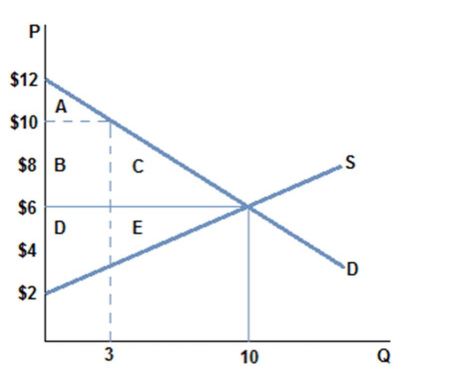Which of the following is not listed in the book as a reason to study economics?
A. to be an informed citizen
B. to learn a way of thinking
C. to understand society
D. to learn how to make lots of money
Answer: D
You might also like to view...
According to the graph shown, if the market goes from equilibrium to having its price set at $10 then:

A. $12 gets transferred from consumer surplus to producer surplus.
B. area C is lost consumer surplus due to fewer transactions taking place.
C. area E is lost producer surplus due to fewer transactions taking place.
D. All of these are true.
When the Fed buys a U.S. government security:
a. the volume of loans issued by the banking system increases and investment will tend to increase. b. the volume of loans issued by the banking system increases and investment will tend to decrease. c. the volume of loans issued by the banking system decreases and investment will tend to increase. d. the volume of loans issued by the banking system decreases and investment will tend to decrease.
When government policies are enacted,
a. equality can usually be enhanced without an efficiency loss, but efficiency can never be enhanced without a reduction in equality. b. efficiency can usually be enhanced without a reduction in equality, but equality can never be enhanced without an efficiency loss. c. it is always the case that either efficiency and equality are both enhanced, or efficiency and equality are both diminished. d. None of the above are correct.
To calculate the marginal utility of consuming the Nth product:
A. divide total satisfaction from consuming all N products by N. B. subtract total satisfaction from consuming N - 1 products from total satisfaction from consuming N products. C. divide total satisfaction from consuming all N products by the price of the product. D. subtract additional satisfaction from consuming the (N - 1)th production from the additional satisfaction from consuming the Nth product.